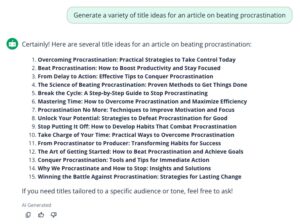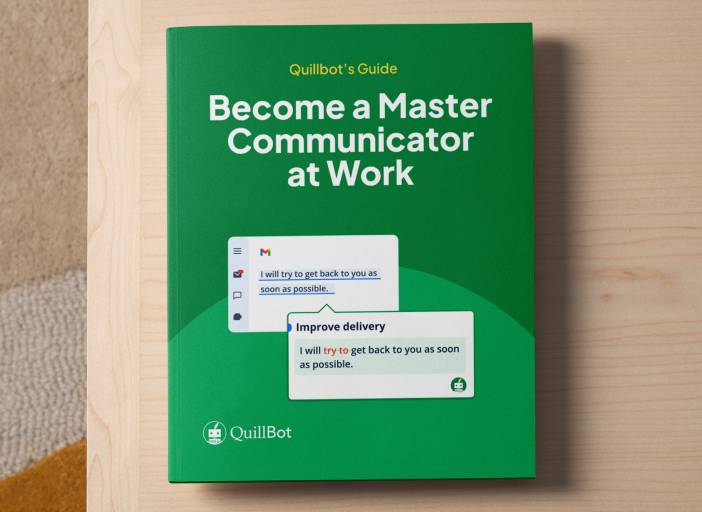How to Create a Title | Tips & Tools
A title is the first thing your audience sees when engaging with your work. The purpose of a title is to identify something, whether it’s an essay, article, book, or academic paper.
A strong title can draw your reader in, capturing their interest and making them want to read more—but a bad title might be the only thing they read before moving on.
One of the hardest parts of creating a memorable title is idea generation. QuillBot’s free AI title generator can help you generate dozens of customized title ideas in seconds.
How to write a strong title
There’s no exact science to crafting the perfect title, but you can keep the following steps in mind as you’re working on something.
1. Finish creating your content
Writing a title should be the last step in your creative process. The purpose of a title is to provide a broad overview that lets your audience know what to expect. If your work is unfinished, it might be challenging to pick a title that fully captures it.
If it bothers you not to have a title, you can use a simple placeholder and update it as your work nears completion.
2. Consider your audience and purpose
Your title should not only summarize your work but also do so in a way that resonates with the people you want to engage. A compelling title will attract your target audience and let them know what to expect.
What counts as an appropriate title depends a lot on circumstance. The best title for a personal blog post will be very different from one for an academic assignment. Consider the following questions as you generate title ideas.
- Who will be reading or engaging with my work?
- What do they care about?
- What is the most important thing they should take away from this?
- What are some key terms I should include? Keep in mind search volume if you want your work to appear on search engine results pages like Google.
- Do I want my title to be more informative or attention-grabbing?
Once you have a better sense of what you’re hoping to achieve with your title, you can start creating a list of options.
3. Generate lots of ideas
It’s usually best to prioritize quantity over quality when coming up with title ideas. It can be helpful to generate a large number of options, choose your favorites, and seek feedback from a supervisor, colleague, or friend.
The following templates may be helpful when thinking of title ideas.
| Template | Example |
| [Catchy Phrase]: [Explanation] | Cracking the Code: An Introduction to HTML for Beginners |
| [Number] Tips for [Action/Goal] | 5 Tips for Staying Focused While Working From Home |
| [Topic] for [Audience] | Time Management Strategies for Undergraduate Students |
| [Problem]: [Proposed Solution] | Burnout at Work: How to Recharge Without Taking a Vacation |
| [Topic]: [Method] | Why We Dream: Insight From Three Decades of Sleep Studies |
| [Quotation]: [Discussion] | “Practice Makes Perfect”: The Science Behind What Actually Helps Us Improve |
| What [Group] Gets Wrong About [Topic] | What Data Scientists Get Wrong About Human Behavior |
A great way to expedite the idea generation process is to use an AI title generator, which can give you a virtually unlimited list of options in seconds.
Using an AI title generator
One of the fastest ways to create a list of potential titles is to use QuillBot’s free title generator. With a simple prompt and the press of a button, you can create any number of titles tailored to your exact needs.

Screenshot
From here, you can give the AI feedback, ask it to revise one of its ideas, or copy and paste your favorite option.
- Generate headline options for a newsletter about time management tips for freelancers
- Generate engaging titles for a LinkedIn post about setting better weekly goals
- Generate title ideas for a piece targeting Gen Z professionals feeling stuck in their careers
Frequently asked questions about how to create a title
- How long should a title be?
-
The best titles are long enough to be informative but short enough to read and understand easily. Include key terms early in your title so your readers quickly know what your work is about.
Title length also depends on context—a novel will generally have a shorter title than an academic paper. Some platforms also have title limits. For example, YouTube video titles are limited to 100 characters.
Here are some general guidelines:
- Blog post: 5–15 words
- Book: 3–5 words
- Essay: 5–10 words
- Research paper: 10–15 words
- YouTube video: 40–70 characters
If you want a short, punchy title but still need to provide more information, consider using a subtitle.When trying to craft a title that’s a certain length, tools like QuillBot’s free AI title generator are a great way to expedite the process.
- What are some examples of strong titles?
-
A strong title is clear and specific and gives the reader a reason to keep reading. Here are some examples of titles across different formats to serve as inspiration.
Blog posts:
- The Science Behind Better Sleep—And How to Get It Tonight
- How to Write Clearer Sentences Using the “Fewer Words” Method
- The Hidden Benefits of Taking Regular Digital Detoxes
YouTube videos:
- Set Up Your Home Office for Success: A Simple Step-by-Step Guide
- I Tried Pomodoro for 30 Days. Here’s What Happened
- Why You Need a Digital Detox and How to Do It Right
Academic papers:
- Evaluating the Impact of Remote Work on Employee Productivity: A Longitudinal Study
- A review of the role of renewable energy sources in environmental protection
- The impact of sleep deprivation on working memory in young adults
Want more ideas? QuillBot’s free AI title generator can generate a customized list of title options tailored to your specific needs.
- What are the guidelines for APA title capitalization?
-
APA title capitalization can be sentence case or title case depending on the type of source and where you’re using the title in the document.
Title case means that you capitalize the first word, major words (e.g., “job” or “parents”), and all minor words that are four letters or longer (e.g., “with”), but not minor words like “at” or “the.”
Sentence case means that you only capitalize the words that you’d capitalize in a sentence—the first word, proper nouns, and the first word after a colon.
When you mention a title within the prose of your document, always use title case (e.g., “The Paradox of Stay-at-Home Parents” in The Atlantic).
In reference list entries, use sentence case for any work that’s contained within a larger source (such as a journal article) as well as self-contained works (e.g., books or websites). The following is an example of a reference entry for a book in APA style.
APA book reference entry example Bradshaw, J., & Ellis, S. (2016). The trainable cat: A practical guide to making life happier for you and your cat. Basic Books.Use title case for the titles of periodicals (e.g., journals) in reference list entries, such as this example for a journal article in APA.
APA journal article reference entry example Maslow, A. H. (1943). A theory of human motivation. Psychological Review, 50(4), 370–396. http://doi.org/10.1037/h0054346QuillBot’s free APA Citation Generator can help you follow APA guidelines for title capitalization in your own writing.
- Is with capitalized in a title?
-
With is capitalized in a title if you are following APA Style because it is a preposition with four letters or more. With is not capitalized in a title if you are following MLA Style, where all prepositions are lowercase.
If you are using a style guide, check its rules for the capitalization of titles. If you are not following a style guide, then you can choose if you want to capitalize “with” in your titles, but it is important to be consistent.
Consult your style guide to see if you should write headings and subheadings in title case or sentence case.
QuillBot’s free Grammar Checker will help you to identify errors with capitalization in your texts.
Cite this Quillbot article
We encourage the use of reliable sources in all types of writing. You can copy and paste the citation or click the "Cite this article" button to automatically add it to our free Citation Generator.
Heffernan, E. (2025, July 15). How to Create a Title | Tips & Tools. Quillbot. Retrieved August 11, 2025, from http://qbot.seotoolbuy.com/blog/ai-writing-tools/how-to-create-a-title/

